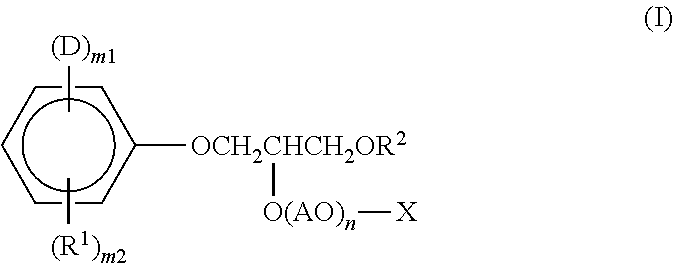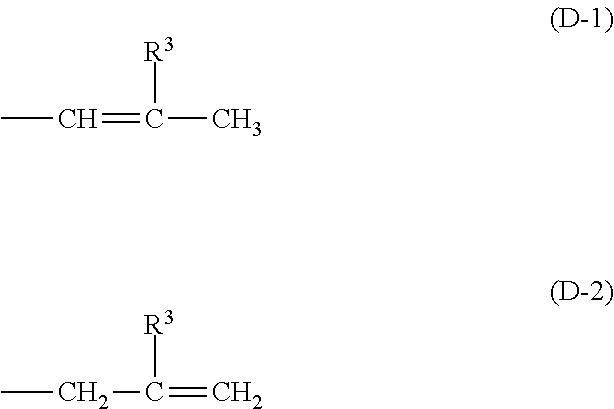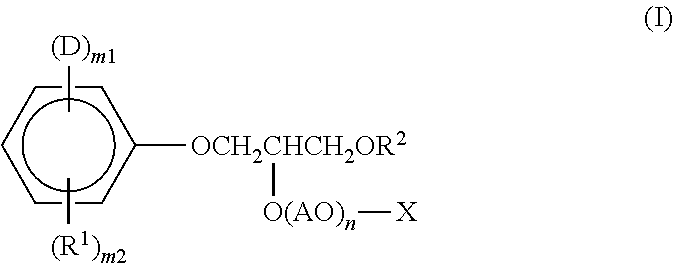Emulsifying agent for emulsion polymerization
a technology of emulsifier and emulsion, applied in the field of emulsifier, can solve the problems of increasing the amount of agglomerates, affecting the stability of polymerization, poor water resistance and adhesive holding power of films, etc., and achieves excellent copolymerization, excellent effect in improving various properties of films, improving heat resistance, adhesive holding power, and weatherability. , the effect of improving the properties of the film
- Summary
- Abstract
- Description
- Claims
- Application Information
AI Technical Summary
Benefits of technology
Problems solved by technology
Method used
Image
Examples
production example 1
[0055]Into a reaction vessel equipped with a stirrer, thermometer, and reflux condenser 94 g (1.0 mol) of phenol, 40 g (1.0 mol) of NaOH, and 210 g of acetone were introduced. With stirring the contents, the internal temperature was elevated to 40° C. Subsequently, 76 g (1.0 mol) of acryloyl chloride was added dropwise thereto over 1 hour. After completion of the dropwise addition, the reaction mixture was further kept at 40° C. for 2 hours and reacted thereby. The reaction product was filtered to remove the NaCl yielded as a by-product, and the acetone was thereafter removed under reduced pressure to obtain 134 g of allyl phenyl ether.
[0056]This allyl phenyl ether was introduced into an autoclave and held at 200° C. for 5 hours with stirring. In this stage, a rearrangement reaction occurred to obtain 2-allylphenol. Into a reaction vessel, 134 g (1 mol) of the 2-allylphenol and 1.3 g of a boron trifluoride ether complex as a catalyst were introduced. In a nitrogen atmosphere, the co...
production example 2
[0058]A compound (invention product 2) represented by the formula (I) was obtained in accordance with Production Example 1, except that the amount of the ethylene oxide was increased from 440 g (10 mol) to 2,200 g (50 mol).
production example 3
[0059]Into a reaction vessel equipped with a stirrer, thermometer, and nitrogen introduction tube, 816 g (1 mol) of the compound (invention product 1) obtained in Production Example 1 was introduced. After replacing the atmosphere in the reactor with nitrogen, 97 g (1 mol) of sulfamic acid was reacted therewith under the conditions of a temperature of 120° C. Thereafter, the reaction product was purified to obtain a compound (invention product 3) represented by the formula (I).
PUM
| Property | Measurement | Unit |
|---|---|---|
| temperature | aaaaa | aaaaa |
| temperature | aaaaa | aaaaa |
| temperature | aaaaa | aaaaa |
Abstract
Description
Claims
Application Information
 Login to View More
Login to View More - R&D
- Intellectual Property
- Life Sciences
- Materials
- Tech Scout
- Unparalleled Data Quality
- Higher Quality Content
- 60% Fewer Hallucinations
Browse by: Latest US Patents, China's latest patents, Technical Efficacy Thesaurus, Application Domain, Technology Topic, Popular Technical Reports.
© 2025 PatSnap. All rights reserved.Legal|Privacy policy|Modern Slavery Act Transparency Statement|Sitemap|About US| Contact US: help@patsnap.com



